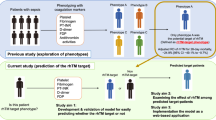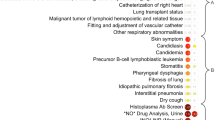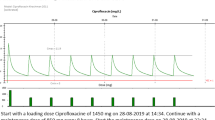Abstract
Purpose
To demonstrate a novel method that utilizes retrospective data to develop statistically optimal dosing strategies for medications with sensitive therapeutic windows. We illustrate our approach on intravenous unfractionated heparin, a medication which typically considers only patient weight and is frequently misdosed.
Methods
We identified available clinical features which impact patient response to heparin and extracted 1,511 patients from the multi-parameter intelligent monitoring in intensive care II database which met our inclusion criteria. These were used to develop two multivariate logistic regressions, modeling sub- and supra-therapeutic activated partial thromboplastin time (aPTT) as a function of clinical features. We combined information from these models to estimate an initial heparin dose that would, on a per-patient basis, maximize the probability of a therapeutic aPTT within 4–8 h of the initial infusion. We tested our model’s ability to classifying therapeutic outcomes on a withheld dataset and compared performance to a weight-alone alternative using volume under surface (VUS) (a multiclass version of AUC).
Results
We observed statistically significant associations between sub- and supra-therapeutic aPTT, race, ICU type, gender, heparin dose, age and Sequential Organ Failure Assessment scores with mean validation AUC of 0.78 and 0.79 respectively. Our final model improved outcome classification over the weight-alone alternative, with VUS values of 0.48 vs. 0.42.
Conclusions
This work represents an important step in the secondary use of health data in developing models to optimize drug dosing. The next step would be evaluating whether this approach indeed achieves target aPTT more reliably than the current weight-based heparin dosing in a randomized controlled trial.



Similar content being viewed by others
References
Celi LA, Mark RG, Stone DJ, Montgomerey RA (2013) Big Data” in the Intensive Care Unit. Closing the Data Loop. Am J Resp Crit Care Med 187(11):1157–1160
Alban S (2012) Adverse effects of heparin. In: Lever R, Mulloy B, Page CP (eds) Heparin—A Century of Progress. Springer, Berlin, pp 211–263
Raschke RA, Reilly BM, Guidry JR, Fontana JR, Srinivas S (1993) The weight-based heparin dosing nomogram compared with a standard care nomogram: a randomized controlled trial. Ann Int Med 119(9):874–881
Hirsh J, Raschke R (2004) Heparin and low-molecular-weight heparin - the seventh ACCP conference on antithrombotic and thrombolytic therapy. Chest 126(3 suppl):188S–203S
Cruickshank MK, Levine MN, Hirsh J, Roberts R, Siguenza M (1991) A standard heparin nomogram for the management of heparin therapy. Arch Intern Med 151(2):333–337
Hirsh Jack et al (2001) Guide to anticoagulant therapy: heparin a statement for healthcare professionals from the American Heart Association. Circulation 103(24):2994–3018
Krishnaswamy Amar, Michael Lincoff A, Cannon CP (2010) The use and limitations of unfractionated heparin. Crit Pathw Cardiol 9(1):35–40
Lee MS, Wali AU, Menon V et al (2001) The determinants of activated partial thromboplastin time, relation of activated partial thromboplastin time to clinical outcomes, and optimal dosing regimens for heparin treated patients with acute coronary syndromes: a review of gusto-IIb. J Thromb Thrombolysis 14(2):91–101
Raschke RA, Gollihare B, Peirce JC (1996) The effectiveness of implementing the weight-based heparin nomogram as a practice guideline. Arch Intern Med 156(15):1645–1649
Melloni C, Alexander KP, Chen AY et al (2008) Unfractionated heparin dosing and risk of major bleeding in non-ST-segment elevation acute coronary syndromes. Am Heart J 156(2):209–215
Grand’Maison A, Charest AF, Geerts WH (2005) Anticoagulant use in patients with chronic renal impairment. Am J Cardiovasc Drugs 5(5):291–305
Saeed M, Villarroel M, Reisner AT et al (2011) Multiparameter intelligent monitoring in intensive care II (MIMIC-II): a public-access intensive care unit database. Crit Care Med 39(5):952–960
Elixhauser A, Steiner C, Harris DR, Cofey RM (1998) Comorbidity measures for use with administrative data. Med Care 36(1):8–27
van Walraven C, Austin PC, Jennings A, Quan H, Forster AJ (2009) A modification of the Elixhauser comorbidity measures into a point system for hospital death using administrative data. Med Care 47(6):626–633
César F, Hernández-Orallo J, Salido MA (2003) Volume under the ROC Surface for Multi-class Problems. Machine learning: ECML 2003. Springer, Berlin, 108–120
Schaden E, Metnitz PG, Pfanner G et al (2012) Coagulation Day 2010: an Austrian survey on the routine of thromboprophylaxis in intensive care. Intens Care Med 38:984–990
Guervil David J et al (2011) Activated partial thromboplastin time versus antifactor Xa heparin assay in monitoring unfractionated heparin by continuous intravenous infusion. Ann Pharmacother 45(7-8):861–868
Imhoff M, Webb A, Goldschmidt A (2001) Health Informatics. Intens Care Med 27:179–186
Squara P, Foruquet E, Jacquet L et al (2003) A computer program for interpreting pulmonary artery catheterization data: results of the European HEMODYN Resident Study. Intens Care Med 29:735–741
Meyfroidt G, Wouters P, De Becker W, Cottem D, Van den Berghe G (2011) Impact of a computer-generated alert system on the quality of tight glycemic control. Intens Care Med 37:1151–1157
Acknowledgments
Grant R01 EB001659 from the National Institute of Biomedical Imaging and Bioengineering (NIBIB) of the National Institutes of Health (NIH). The sponsors of this research played no role in the research process of this work beyond their important financial contribution.
Conflicts of interest
The authors declare that they have no conflict of interest. None of the authors involved in this study have associations (intellectual, financial, or otherwise) that would affect, or be perceived to affect the author’s research conduct or judgment
Ethical standards
.All data used for this study was de-identified and publically accessible. Hence, it did not require an IRB for the purposes of investigation.
Author information
Authors and Affiliations
Corresponding author
Additional information
Leo A. Celi and John Danziger should be considered co-senior authors.
Take-home message: We demonstrate a novel method that utilizes retrospective data to develop statistically optimal dosing strategies for medications with sensitive therapeutic windows. We illustrate our approach with the example of intravenous unfractionated heparin, a medication which typically considers only patient weight and is frequently misdosed.
Electronic supplementary material
Below is the link to the electronic supplementary material.
Rights and permissions
About this article
Cite this article
Ghassemi, M.M., Richter, S.E., Eche, I.M. et al. A data-driven approach to optimized medication dosing: a focus on heparin. Intensive Care Med 40, 1332–1339 (2014). https://doi.org/10.1007/s00134-014-3406-5
Received:
Accepted:
Published:
Issue Date:
DOI: https://doi.org/10.1007/s00134-014-3406-5




